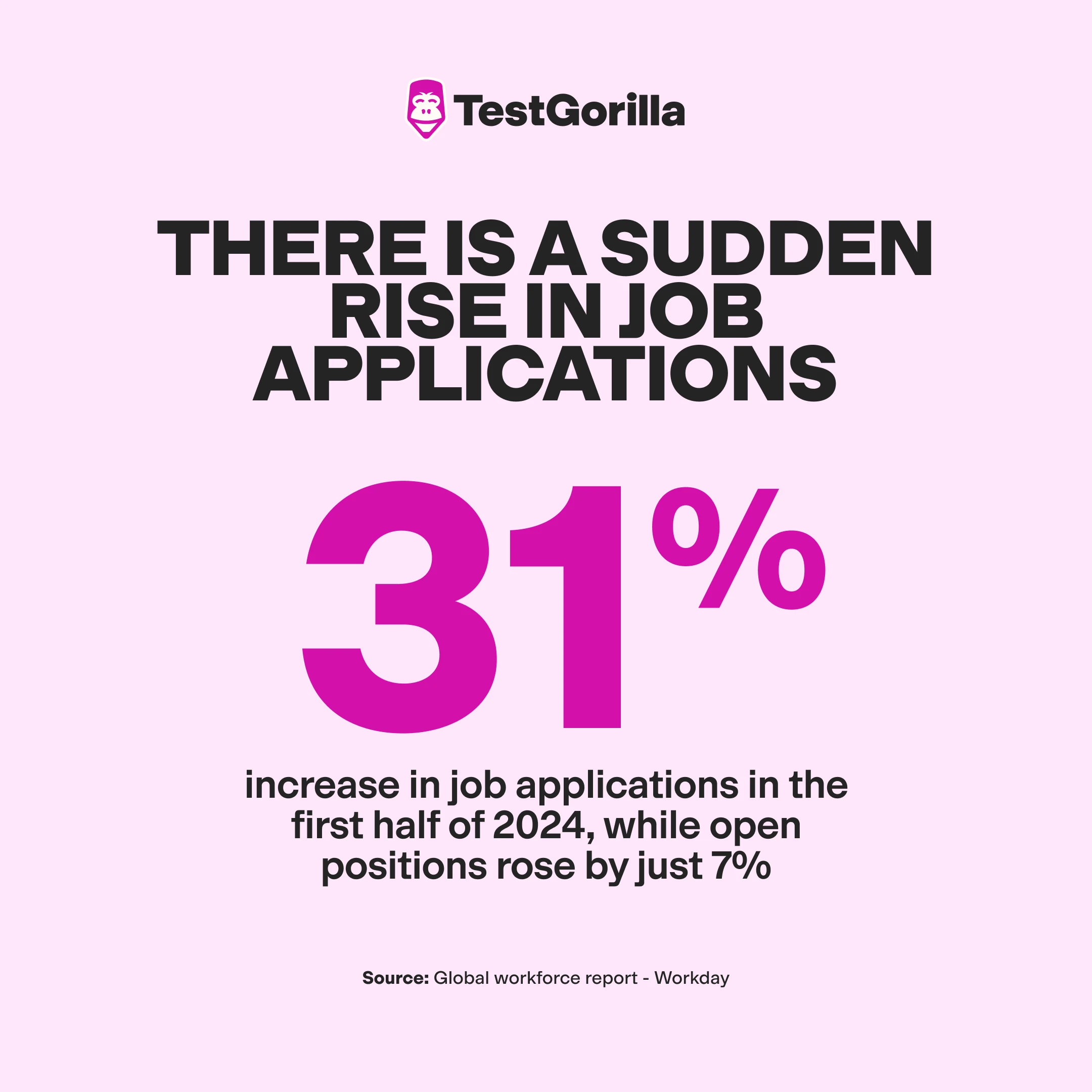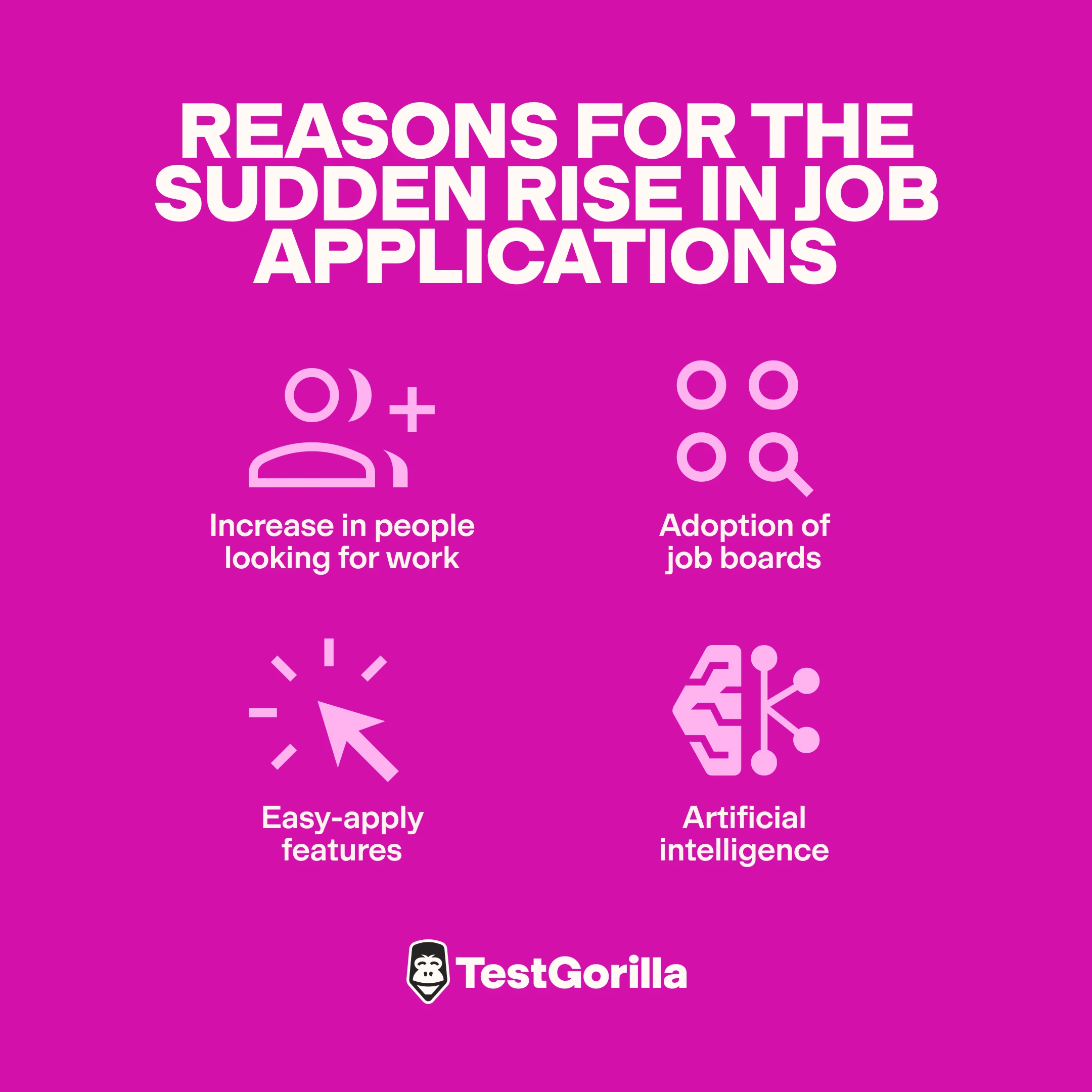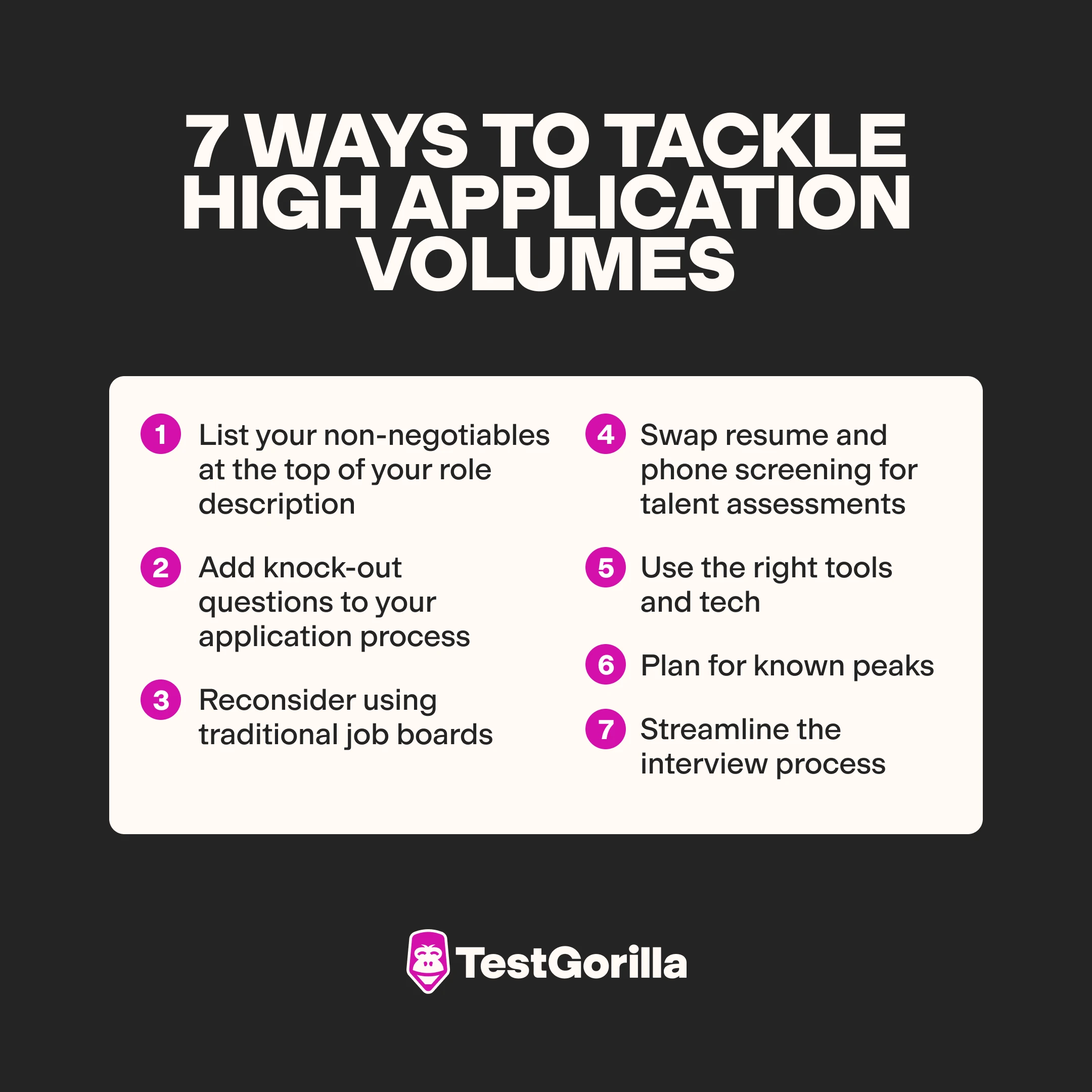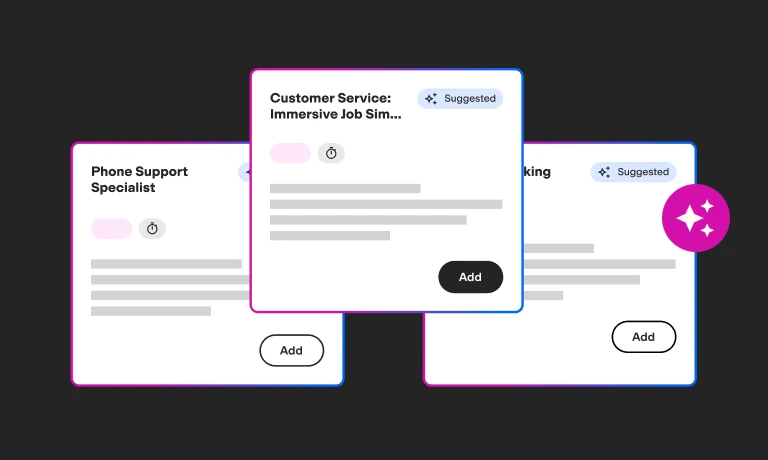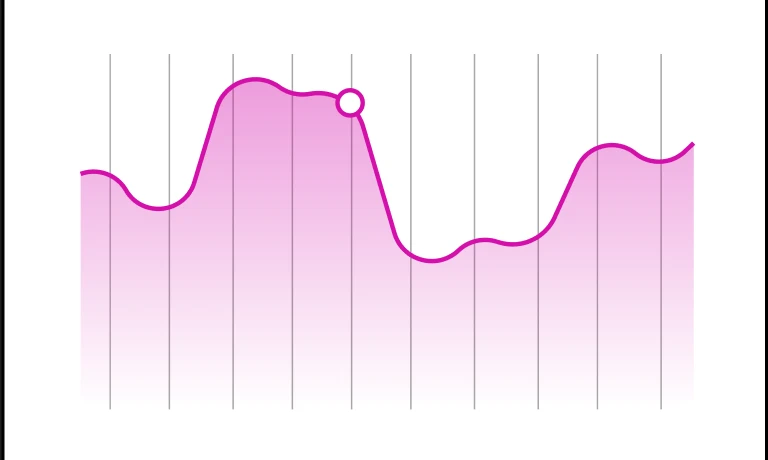Today’s recruiters and hiring managers are often buried under a mountain of job applications – many of which aren’t even close to a good fit for the role.
We’ve been there and know how frustrating it is. You spend hours sifting through resumes and cover letters – time you could have used to develop and implement key talent acquisition strategies. Worse, the panic to get through these applications often leads to rushed decisions, hiring mistakes, and missed opportunities.
But there’s good news: You don’t have to choose between speed and quality.
Below, we share seven strategies to help you manage high application volumes without compromising on the quality of your hires.
Why the sudden rise in job applications?
According to Workday's new Global Workforce Report, job applications grew by 31% in the first half of 2024, while open positions rose by just 7%. Let's look at why applications are surging four times faster than job openings.
1. Increase in people looking for work
According to the US Bureau of Labor Statistics (BLS), the labor force grew in 2024 and is expected to continue growing. The BLS attributes some of this to the growing population of women and ethnic minorities looking for work.
One article by JP Morgan explains that a rise in immigration is "leading to an increased potential workforce and upping the pace of jobs growth," whilst NBC news reports that economic uncertainty and the fear of being laid off has prompted 28% of Americans to look for new jobs – the highest in a decade.
2. Adoption of job boards
The number of users on platforms like LinkedIn has risen exponentially in the last five years and will continue to increase. More people accessing LinkedIn and other job boards has contributed to the rise in job applications.
3. Easy-apply features
According to Forbes, some job boards let candidates apply for a role with a single click of an “easy apply” button, automatically submitting their saved resumes for the role. With less effort required, job seekers are applying for roles left, right, and center – often without checking if they’re eligible.
4. Artificial intelligence (AI)
A Capterra survey of nearly 3,000 job seekers showed that roughly 6 in 10 applicants use AI tools to support their job applications. For instance, 37% use it to identify suitable openings, 40% to write or improve resumes, and 33% to refine cover letters.
Notably, candidates using AI assistance submitted 50% more applications than those who didn’t. Overall, this has doubled the number of applications per role.
7 ways to tackle high application volumes
Below, we explain how to prevent a sea of applications – and how to find your perfect candidate if a surge does happen.
1. List your non-negotiables at the top of your role description
Employers often start their role descriptions with information about the job and company. They only add what they’re looking for from ideal candidates toward the end. HR and hiring expert Yashna Wahal explains how this job description structure can be problematic:
“With the ease of crafting applications today, it’s likely that applicants are only glossing over role descriptions – often without getting to the end before shooting their shot.”
Listing non-negotiables – such as mandatory qualifications, working arrangements, technical skills, and experiences – at the top of your job description can serve as a self-selection tool, deterring candidates who don’t meet the essentials. This makes your applicant pool more manageable, saving time and effort in screening candidates.
Recalling a personal success with this strategy, Wahal shared with TestGorilla:
“Adding non-negotiables like ‘the role requires candidates to work night shifts’ at the top of my operations manager role description helped me attract only those candidates willing to work late.”
Here are some ways to do this:
Pinpoint the skills, qualities, and requirements essential to the role and add them toward the start of your role description.
Be specific – for instance, ask for “experience with Meta Ads Manager” instead of just “social media marketing experience.”
Use bullet points and bold formatting to ensure candidates don’t miss them.
Need help crafting stellar job descriptions? Check out our free job description templates for every role.
2. Add knock-out questions to your application process
Worried about candidates ignoring your job description and applying anyway? Knock-out questions allow an extra layer of self-selection to prevent unqualified candidates from applying for a job.
What are knock-out questions? These are yes-or-no type screening questions that automatically disqualify candidates if they respond “no” to an answer. These questions should be specific and clearly reflect your deal-breakers for the role.
Here are some examples of knock-out questions:
Do you have a valid Certified Public Accountant (CPA) license?
Can you code in Python using libraries like Pandas or NumPy?
Are you authorized to work in [specific location] without sponsorship?
You can deter unsuitable candidates from applying by embedding these questions in the application process. One study found that ten screening questions led to a 17% abandonment rate, while 20 screening questions resulted in a staggering 44% dropping out.
As long as your knock-out questions cover genuine must-haves only, you can avoid high application volumes without losing top talent.
If a handful of unfitting candidates still apply, you can use an applicant tracking system (ATS) that auto-rejects candidates who don’t meet your baseline criteria.
3. Reconsider using traditional job boards
Popular job boards like LinkedIn and Monster can help you cast a wider net, but this net often teems with ill-fitting candidates. Mike Fretto, Creative Director at Neighbor, a non-profit organization, has seen this firsthand: “We've actually started avoiding large job sites like Indeed and LinkedIn due to the sheer volume of applicants with AI-optimized resumes we have to deal with.”
Further, Research shows employers make only one quality hire from every 46 applications on job boards. Additionally, only a fifth of successful hires come from traditional job boards.
That's why you must carefully consider whether posting to job boards is worthwhile or if you can find suitable candidates for your role elsewhere.
Here are some alternative options:
Careers page
Posting your open roles on the careers page on your website is a great way to attract only those applicants who’ve visited your page and shown a genuine interest in working for your company. Research shows you can make one quality hire for every 26 applications on your careers page – much better than popular job boards.
Internal mobility
Consider opening your roles internally first before posting on traditional job boards. The above study found that internal mobility has the best odds and success rate – with one successful hire for every five applications. This way, you can avoid large application volumes while still finding top-notch candidates.
Special job boards
Consider using industry-specific job boards – for instance, Idealist for nonprofit roles or AngelList for startups. While these see fewer users than bigger job boards, you're more likely to find skilled candidates.
4. Swap resume and phone screening for talent assessments
It takes recruiters almost 7.5 seconds to screen a single resume, which can add up when application volumes are surging. And after all that effort, 43% of employers still find it challenging to rank applicants or determine their skills from their resumes.
Screening calls are even worse. With each call lasting between 15 and 30 minutes, it’s a huge waste of time to call hundreds of candidates – especially when only 12% meet job requirements.
The best way to quickly and accurately screen any number of applications is through pre-employment testing.
Roll out online talent assessments to test candidates’ hard and soft skills, cognitive abilities, personality traits, and cultural contributions at the first step of the application process.
This skills-based approach not only saves you the time and hassle of reviewing so many applications but also gives you an objective and holistic picture of candidates’ capabilities. Speed? ✅ Quality? ✅
We surveyed over 1,000 employers and found of those using skills-based hiring:
90% improved diversity
90% reduced mis-hiring
81% cut time-to-hire
Want to learn more about how to implement skills-based hiring for better, faster, and cheaper recruitment? Read our complete skills-based hiring handbook.
5. Use the right tools and tech
Technology is a game-changer when dealing with numerous job applications, helping you scan resumes, communicate with candidates, and more.
Here are some tools you can consider adding to your hiring tech stack:
Applicant tracking systems
These systems are the backbone of recruitment today. A good ATS can organize incoming applications and sort resumes based on specific keywords or search criteria.
For instance, say you’re looking for candidates with experience in healthcare. You can add keywords like “clinic,” “nurse,” etc., and the ATS will automatically flag candidates whose applications contain these words – saving you the need to do this manually for hundreds of applications.
An ATS also provides tools to help you communicate with candidates. You don't need to save each candidate's contact details and email them separately.
Moreover, some systems let you automate candidate communications – for instance, messages thanking candidates for their submissions or informing candidates of application rejections. These tools are especially handy when you need to perform bulk actions.
Lastly, an ATS is great for tracking candidate progress – who’s at what stage of the process, what feedback they received from interviewers, and so on. By streamlining these aspects of the recruitment process, you can avoid the tedious tasks and inevitable mistakes you'd otherwise experience with high application volumes.
In fact, Amanda Dixon, founder of gomerge.com, told TestGorilla that these systems helped her “cut down the hiring time without cutting corners.”
Scheduling software
Coordinating interviews can be a headache – especially when dealing with a surge in application numbers. Scheduling tools like Calendly or Microsoft Bookings let candidates select interview slots from pre-set availability provided by the interviewer.
They can even integrate with interviewers' calendars and auto-populate their availability. This means there’s no back-and-forth in working out who can meet when.
Video interviewing platforms
In some cases, even your shortlisted candidates can be a long list, and interviewing each of these candidates can be tedious. Video conferencing sites like Zoom give you a platform to conduct interviews virtually, at the very least saving you time in scheduling and planning for in-person visits.
But the real value-add comes from one-way video interview software. This lets candidates answer pre-set interview questions on video, and you can review their answers in your own time. While this is still time-consuming, it’s much less effort than virtually attending multiple interviews and asking the same questions repeatedly.
Candidate relationship management (CRM) software
Widely used for talent pipeline management, recruitment CRM software is a great way to collect and manage candidate relationships.
Why does this matter for surging application volumes?
While it doesn't directly streamline screening processes, it’s a great way to add those hundreds or thousands of applicants to your talent pipeline, ensuring you don't forget to do this when dealing with job applications.
Artificial intelligence (AI) tools
The rise of AI as a hiring trend is no surprise, as research suggests 43% of HR professionals already use AI in recruitment.
Moreover, there’s evidence to suggest that the use of AI in resume screening, candidate matching, candidate communications, and video interview analysis boosts efficiency in hiring – just what you need for large volumes of applications.
Jacob Kalvo, entrepreneur and member of the Forbes Technology Council, agrees:
"We use applicant tracking systems with AI capabilities that sift through applications to show only the most relevant candidates and do this much faster.
This allows us to use our time effectively to evaluate applicants who will more likely fulfill the needs of the particular role; this maintains efficiency and does not allow us to be overwhelmed by the number of applications."
That said, there are also valid arguments and real-life case studies about the accuracy of AI.
Amazon, for example, had to terminate an AI-driven screening process because it perpetuated gender biases and picked male resumes over female ones. HireVue, an AI-driven HR platform, also discontinued its facial expression analysis software due to inaccuracies while evaluating candidate videos.
At TestGorilla, we believe you can make the most of AI while mitigating known risks.
Our advice? Avoid using AI to screen applications or analyze video interview recordings – even if they’re in large numbers. Instead, consider using AI chatbots for candidate communications, generative AI for summarizing interview feedback, and other indirect AI applications to save time and effort when working with a surge in volumes.
Importantly, audit your chosen AI tools regularly and always add a human touch to your hiring process, even if it's a bit of extra work.
6. Plan for known peaks
Application surges don’t always come as a surprise – employers often deal with seasonal peaks in job applications. For instance, you could see a rise in enthusiasm after a recent job fair or experience a seasonal influx during graduate recruitment cycles.
Additionally, it’s not uncommon to have more interest just after bonus cycles – for example, at the end of the year. This is when employees looking to move often start applying for other jobs.
Planning for these peaks by arranging extra support and resources, optimizing workflows, and implementing the right tools can help you deal with surges without compromising candidate quality.
Jacob Kalvo offered a great tip for this:
"Seasonal or spike-related hiring needs to be planned well in advance, with flexible resources. During peak times, temporary support either from contracted recruiters or reallocation of internal resources to help with screenings can make quite a difference."
In addition to extra pairs of hands, here's how you can plan for seasonal surges:
Analyze historical data to spot application trends and determine when you'll experience a rise in applications.
Subscribe to the right software and technology in advance so you can automate some of your tasks as soon as things pick up.
Ask interviewers to pre-select their available slots so you don’t have to do this at the last minute.
Refine your job descriptions and set your knock-out questions early to prevent unqualified applications to the best of your ability.
7. Streamline the interview process
When application volumes are high, the last thing you want is to get bogged down in arranging and evaluating many long interviews. Here’s how you can streamline your interview process to ensure you and your hiring team spend time wisely:
Interview skilled candidates only. Use talent assessments to shortlist and interview candidates who already have the technical and soft skills needed for your role.
Combine interview stages. Instead of having many rounds, consider combining stages (for instance, technical and behavioral rounds) or conducting panel interviews to save time. Data suggests two or three interviews are enough for the average job.
Use structured interviews. These involve asking predefined questions that prevent the conversation from going off on a time-wasting tangent.
The best insights on HR and recruitment, delivered to your inbox.
Biweekly updates. No spam. Unsubscribe any time.
Screen applications faster with talent assessments and more
A growing labor force, increased adoption of job boards, and a rise in AI assistance have led to a spike in job applications. While this surge can bring in talented candidate profiles, finding top-notch candidates in a pile of applications – most of them low-quality – isn’t easy. It’s a time-consuming, error-prone process.
To prevent and handle high application volumes efficiently, clarify your must-have candidate requirements, ask knock-out questions, avoid popular job boards, and use tech and AI.
Most importantly, use skills assessments to screen candidates before you review a multitude of applications. This strategy works quickly and helps you spot and hire the best talent among the clutter.
Related posts
You've scrolled this far
Why not try TestGorilla for free, and see what happens when you put skills first.


